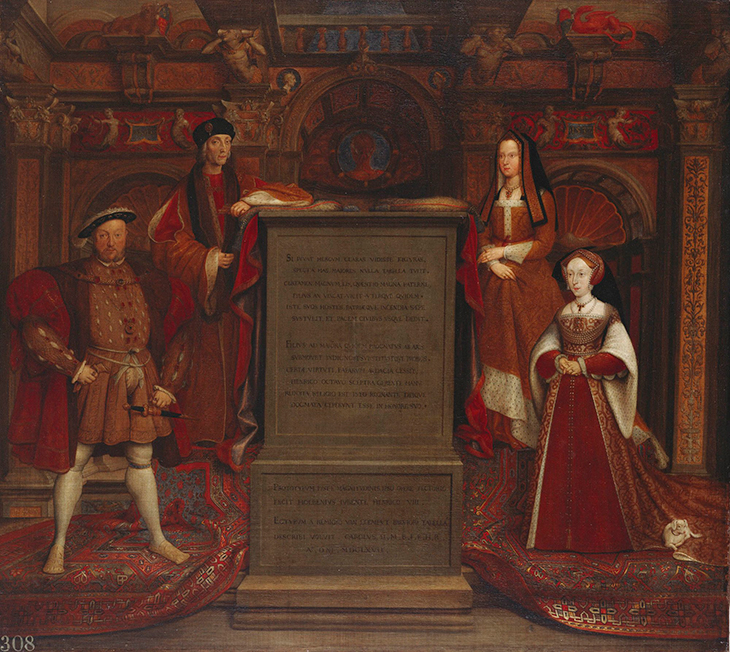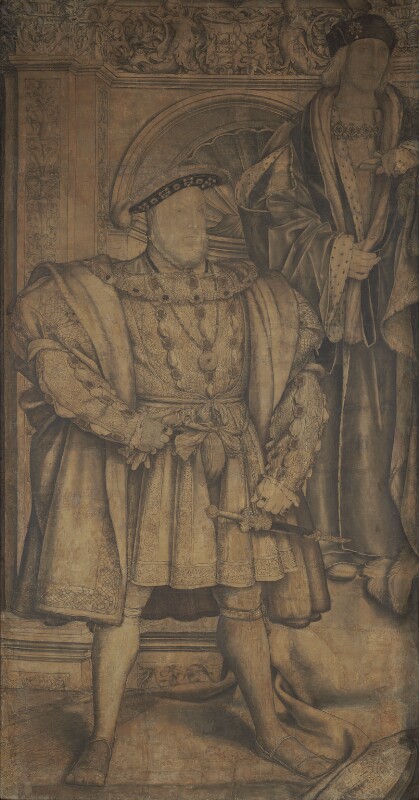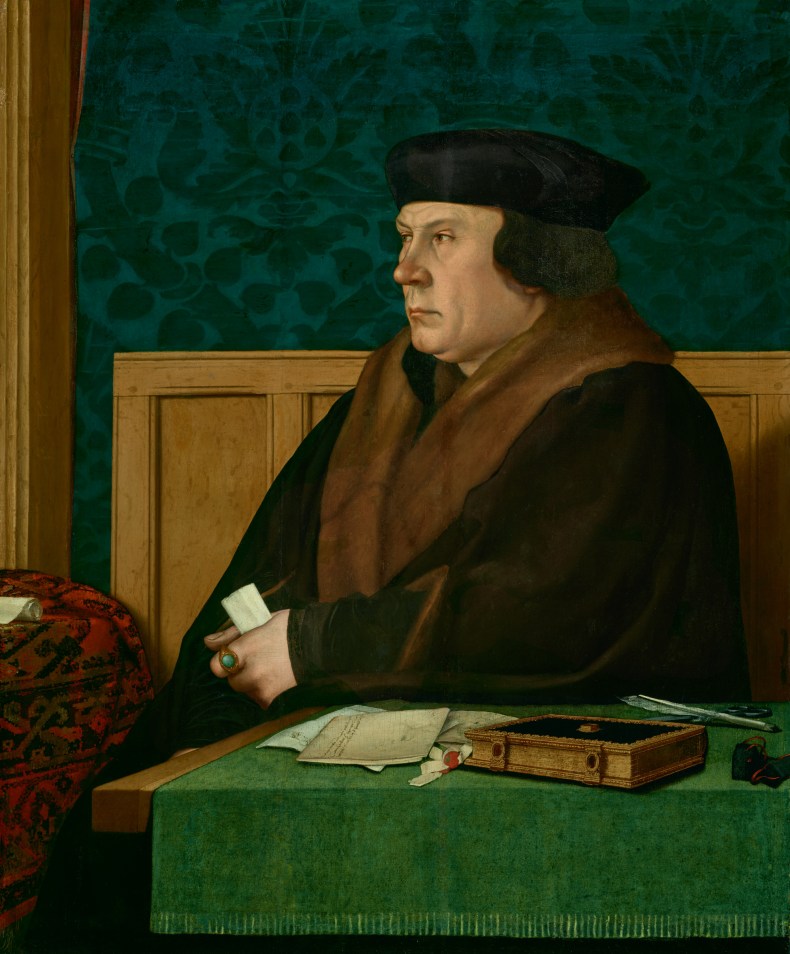How much of our insatiable appetite for the Tudors can be ascribed to just one man? If Hans Holbein the Younger had never come to England, driven from his native Basel by the withering of the arts under Protestant iconoclasm, would we have anywhere near as vivid or compelling a picture of Henry VIII and the women and men who lived, and died, at his court? Clearly personality counts for something, and a king who took six wives and beheaded two of them would not easily be forgotten, but our collective mental image of that magnificent, trapezoidal man with cruel piggy eyes is in large part the creation of Holbein. It seems only fitting then that this perspicacious artist features throughout Hilary Mantel’s trilogy of novels about Thomas Cromwell, often as a wry commentator on the gulf between representation and reality: a recurring motif in these books, which bring their people to life and colour them in with as much clarity and force as a Holbein portrait.
Henry VII, Elizabeth of York, Henry VIII and Jane Seymour (detail) (1667), Remigius van Leemput (after Hans Holbein). Hampton Court Palace. Photo: Royal Collection Trust/© HM Queen Elizabeth II 2020

Mantel’s attentiveness to the everyday details of Tudor life takes in the full sweep of the period’s visual and material culture, from the famous Whitehall Mural to a lady’s embroidered kerchief. As Mantel has said, the novelist gets to work ‘where the facts run out’, and she fills gaps in the art historical record just as subtly. In The Mirror and The Light, we look over Holbein’s shoulder during Henry’s sittings for the Whitehall Mural. The original perished in the Whitehall fire of 1698 but is known to us through a 17th-century copy in oils and part of Holbein’s original cartoon. At some point between the design and the completed painting Holbein decided to turn Henry towards the viewer, moving him from a three-quarter view to confront us face-on. Art historians usually attribute this alteration to Holbein’s own brilliance, but in a knowing nod to the historical record Mantel gives the decision to Cromwell:
‘Master Holbein? Bring your drawing. The king’s face. Let me see.’
Hans whistles up a boy, who scuffles through the sheets bearing the king’s head, till he finds a version the master is content to show. He, Cromwell, puts his thumb on the king’s forehead, as if he were smudging him with chrism. ‘Turn the head. Turn it full on. Make him look at us.’
Initially Holbein is sceptical: ‘“God in Heaven,” Hans says, “that will be frightening. Turn body and all?’”, but at the mural’s unveiling Cromwell is vindicated. ‘“By the saints you were right,” Hans whispers, “when you said I should turn him to face us.” He seems awed by his own creation. “Jesus Maria. He looks as if he would spring out of the frame and trample you.”’
King Henry VIII; King Henry VII (c. 1536–37), Hans Holbein the Younger. National Portrait Gallery, London.
Creative Commons licence (CC BY-NC-ND 3.0)

That Cromwell should display such visual sensitivity is not at all implausible. He enthusiastically patronised Holbein after the artist’s first English patron, Thomas More, was executed, including commissioning a portrait of himself from the artist, and we know from Cromwell’s inventories that he had an extensive collection of secular and religious artworks. This included paintings of Lucretia Romana and the Battle of Pavia (showing the defeat and humiliation of Henry VIII’s French rival Francis I) along with paintings of the Nativity and the Passion of Christ. Having such an extensive art collection was highly unusual at the time, even for a noble-born courtier; we might ask why Cromwell, famous for his reforming tendencies, should own paintings of such traditional religious subjects?
In fact, their presence in his collection points to an even more precocious mindset, suggesting that he was able to set aside the (highly Catholic) religious purposes of the images and enjoy them for their artistic skill. Such an attitude was widespread in Renaissance Italy, but in Tudor England few people thought of art in this way, seeing it more as a means to communicate important political, religious or personal messages than as something to be appreciated for its own sake.
Thomas Cromwell (1532–33), Hans Holbein the Younger. The Frick Collection, New York. Photo: Michael Bodycomb

This aspect of Tudor art also features in Mantel’s writing. Throughout the books, gifts bind people together. They could be tokens of affection, or reminders of a debt. At one point in The Mirror and The Light Cromwell ‘finds himself thinking of his spectacular bed: the king has given him a set of covers and bed hangings, purple woven with silver tissue, emblazoned with the royal arms. You are mine asleep or awake, Henry is saying: like a lover.’ Henry’s wives are marked out in a similar way, his initials expressing his ownership of them:
He approaches the king. About his neck, as deputy for the Mirror of Naples, Henry is wearing a rough-cut diamond the size of a large walnut. His doublet of crimson satin is sewn all over with gold and pearls, picking out the queen’s initial. Jane’s crimson sleeves are stiff with matching letters: H, H, H again.
The description evokes the doomed initials ‘HA’, ‘AR’, on the chapel screen in King’s College, Cambridge and elsewhere: short-lived intertwinings which could be quickly adapted or erased. This palimpsest of Tudor culture, in which clothes, jewels and servants were repurposed and assigned to new owners, is brought vividly to life in the series’ first instalment, Wolf Hall. For her coronation Anne Boleyn is collected ‘in her own barge – Katherine’s old one, rebadged, twenty-four oars’. Bastard children receive the same treatment: ‘Mary’s old servants are about, faces he has seen before; there are clean patches on their jackets where Mary’s livery badge has been unpicked and replaced by the king’s badge’. In The Mirror and The Light Mantel walks us through the queen’s apartments at the Tower of London, sizing up necessary preparations for Henry’s fourth wife, Anne of Cleves:
Lord Cromwell stands before the image of the late queen [Jane Seymour], painted on the wall by an uncertain hand. He sees a pale round face, a fall of yellow hair. He wonders, will it double for Anna? Or must I repaint? I should not like to obliterate such a good lady. Anne Boleyn is lurking within the plaster, her dark gaze burning through.
This semi-successful layering of new paint and portraits reminds us that not everything is so easily erased. At one point in Wolf Hall Cromwell cries over an illuminated prayer book, shortly after the deaths of his daughters. He is found by his colleague George Cavendish, who assumes he is praying. But, Mantel writes, ‘Cavendish cannot see his daughter’s fingers touching the page, or his wife’s hands holding the book. George simply looks at the pictures, upside down.’ In art history, like Cavendish, we are drawn by necessity to the obvious purposes of an object and think only secondarily, if at all, of the other emotions and associations in which it was once embedded. Such associations were often unrecorded, lost now to the diligent enquiries of the art historian, though indications of use and adaptation occasionally bring them to light. But really, the novelist has the advantage, as she is able to restore to artworks the mental and emotional layers that once inhabited them and make us see them again, as if for the first time.
Christina J. Faraday is an Affiliated Lecturer in the History of Art department at the University of Cambridge. She specialises in the art and architecture of Tudor England.



